Did you know that the oldest known wooden boat fragments in the Philippines date back to 320 AD? This discovery highlights the remarkable craftsmanship of pre-colonial Filipinos, who excelled in creating functional yet artistic objects. Long before modern tools, these early artisans used their skills to shape wood, stone, and other materials into works that reflected their spiritual beliefs and community values.
Sculpture and carving were more than just creative expressions; they were integral to daily life and rituals. From intricate gold statuettes like the Agusan image to wooden boat fragments, these artifacts tell a story of a rich cultural heritage. These forms of art were not only utilitarian but also served as symbols of identity and spirituality.
Exploring these ancient practices offers a glimpse into the history and culture of the Philippines. It reveals how early Filipinos used their environment to create lasting legacies. Their work continues to inspire modern artists and preserve the essence of Filipino identity.
Key Takeaways
- Pre-colonial Filipinos were skilled in sculpture and carving, creating both functional and spiritual objects.
- Artifacts like the Agusan image and wooden boat fragments highlight their craftsmanship.
- These art forms were deeply tied to community values and beliefs.
- Pre-colonial art continues to influence modern Filipino culture.
- Exploring these works provides insight into the Philippines’ rich history.
Introduction to Pre-Colonial Philippine Sculptures and Carvings
From spiritual icons to everyday objects, pre-colonial sculptures tell a story of Filipino heritage. These works reflect the rich culture and history of early communities, blending functionality with artistic expression. Whether carved from wood or shaped from stone, each piece showcases the craftsmanship of its creator.
Pre-colonial Filipinos used natural materials like wood, stone, and gold to create their works. The Agusan image, a 21-karat gold statuette, is a prime example of their skill. Similarly, the Ifugao rice gods, or bulul, were carved to protect crops and honor spiritual beliefs. These pieces were not just decorative; they served practical and sacred purposes.
“The art of carving was a way to connect with the divine and the natural world.”
Carving methods varied by region and purpose. In the Cordilleras, artisans created intricate rice gods to ensure bountiful harvests. In Agusan, goldsmiths crafted detailed statuettes for rituals. These techniques were passed down through generations, preserving traditional practices.
| Artifact | Material | Purpose |
|---|---|---|
| Agusan Image | Gold | Ritual and spiritual |
| Ifugao Rice Gods | Wood | Agricultural protection |
| Butuan Boats | Wood | Transportation and trade |
These sculptures and carvings were deeply integrated into daily life. They adorned homes, protected crops, and played roles in ceremonies. Exploring these works provides insight into the history and culture of the Philippines, revealing a legacy that continues to inspire today.
Historical Context of Pre-Colonial Philippine Art
The Angono Petroglyphs, dating back to 3000 BC, reveal the earliest forms of artistic expression in the Philippines. These ancient carvings depict scenes of daily life and rituals, offering a glimpse into the culture and history of early Filipino communities. Pre-colonial art was not just about aesthetics; it was deeply tied to the purpose of preserving traditions and connecting with the spiritual world.

Cultural and Historical Influences
Pre-colonial Filipino art was shaped by a blend of indigenous traditions and external cultural exchanges. Indigenous beliefs and ritual practices played a significant role in shaping artistic styles. For example, the Ifugao rice gods, or bulul, were carved to ensure bountiful harvests and honor spiritual beliefs.
Trade routes like the Silk Road also influenced Filipino art. Gold mining, which began around 1000 BC, led to the creation of intricate ceremonial objects. These pieces were not just decorative; they symbolized social status and identity.
Timeline of Artistic Development
The evolution of pre-colonial art can be traced through key milestones. The Angono Petroglyphs, from 3000 BC, are the oldest known artworks in the Philippines. By 900 AD, the Laguna Copperplate Inscription highlighted early literacy and cultural practices.
By the 13th century, goldsmiths in the Philippines were crafting detailed statuettes like the Agusan image. These works reflect the artist‘s skill and the cultural values of their time. Each period contributed to the rich tapestry of Filipino art history.
Pre-Colonial Art: A Cultural Legacy
The legacy of pre-colonial Filipino craftsmanship continues to shape modern cultural identity. These early works were not just decorative; they were deeply tied to the culture and history of the communities that created them. From intricate carvings to symbolic designs, pre-colonial art reflects a rich heritage that remains relevant today.
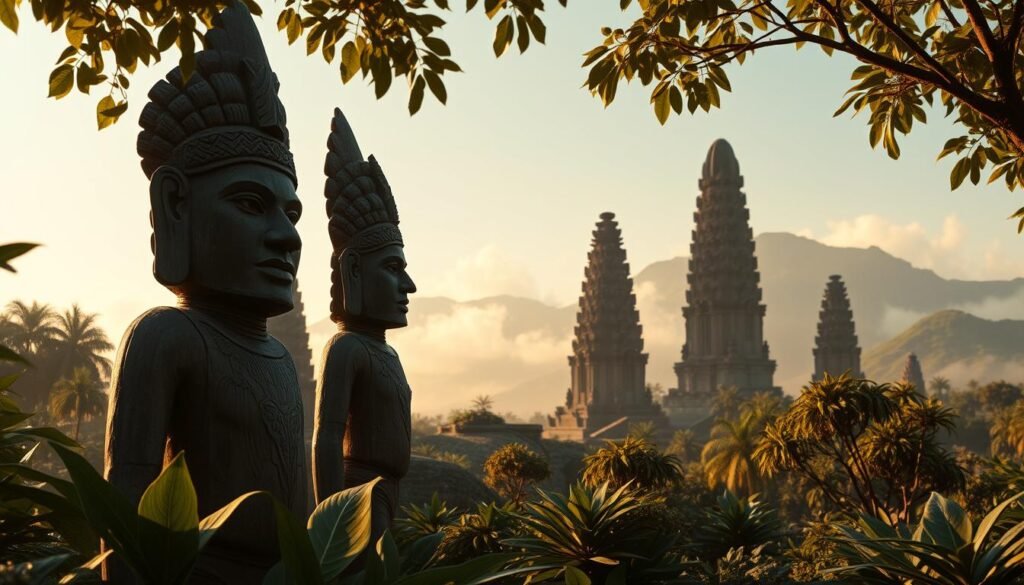
Defining Characteristics of Early Art
Pre-colonial art is defined by its symmetry, intricate detail, and spiritual symbolism. These characteristics set it apart from later periods. For example, the Ifugao rice gods, or bulul, were carved with precision to honor spiritual beliefs and ensure bountiful harvests.
Artisans used natural materials like wood, stone, and gold to create their works. Each piece was more than an artwork; it was a reflection of the community’s values and connection to the divine. The Agusan image, a gold statuette, is a prime example of this craftsmanship.
These art forms were integral to daily life. They adorned homes, protected crops, and played roles in ceremonies. This dual purpose—functional and spiritual—highlights the depth of pre-colonial culture.
| Artifact | Material | Symbolism |
|---|---|---|
| Ifugao Rice Gods | Wood | Agricultural protection |
| Agusan Image | Gold | Spiritual connection |
| Angono Petroglyphs | Stone | Daily life and rituals |
Pre-colonial art continues to inspire modern Filipino artists. Its influence can be seen in contemporary designs and cultural practices. By exploring these works, we gain insight into the history and values of early Filipino communities.
Museums and exhibitions play a crucial role in preserving this legacy. They showcase artifacts that tell the story of a vibrant culture. Through these efforts, the essence of pre-colonial art remains alive, connecting the past with the present.
Sculpture Techniques and Carving Methods
The craftsmanship of pre-colonial Filipino sculptors was deeply rooted in their environment and traditions. Their ability to transform raw materials into intricate works reflects a profound connection to nature and culture. This section explores the materials, tools, and techniques that defined their practice.
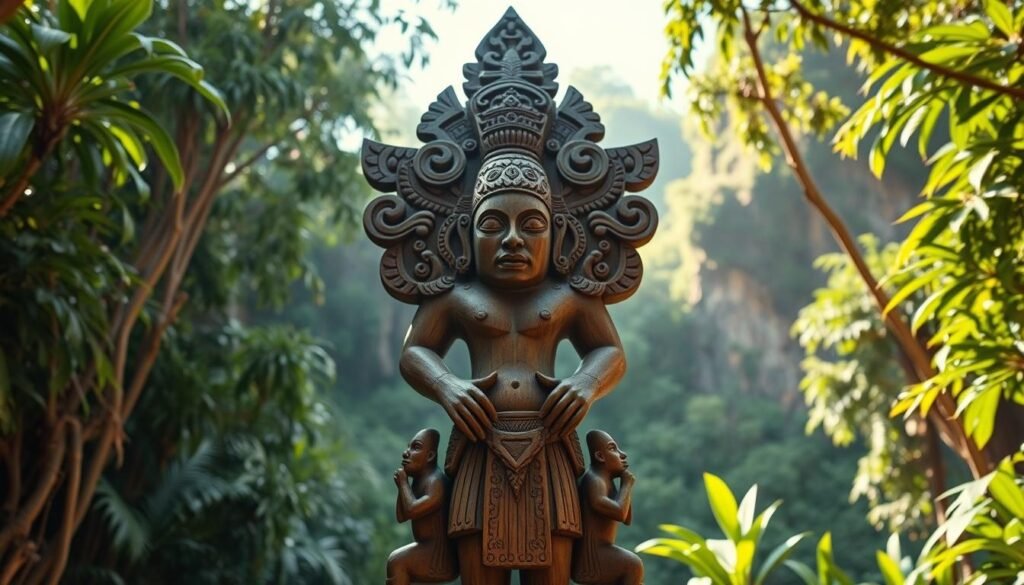
Materials and Tools Utilized
Pre-colonial sculptors relied on natural resources like wood, stone, and metal. Hardwoods such as narra and molave were favored for their durability and fine grain. Stone, including limestone and marble, was used for its permanence and texture. Metal tools, like chisels and adzes, were essential for shaping these materials.
Each material held cultural significance. Wood symbolized life and growth, while stone represented strength and endurance. The tools, often passed down through generations, were extensions of the artist‘s skill and creativity.
Traditional Techniques and Styles
Hand-carving was the primary method, requiring precision and patience. Sculptors used techniques like direct carving, where the final form emerged from the raw material without preliminary models. This approach allowed for a deep connection between the artist and their work.
Intricate detailing and surface finishing were also common. Patterns and motifs often reflected spiritual beliefs or community values. For example, the bulul statues of the Ifugao were carved with specific rituals to ensure their protective power.
These traditional methods continue to inspire modern sculpture, bridging the gap between past and present. By studying these techniques, we gain insight into the history and culture of the Philippines.
Influence of Trade and Global Interaction
Trade routes like the Silk Road played a pivotal role in shaping pre-colonial Philippine art. These networks connected the Philippines to neighboring regions, fostering an exchange of ideas, materials, and techniques. This global interaction introduced new styles and enriched the cultural heritage of early Filipino communities.
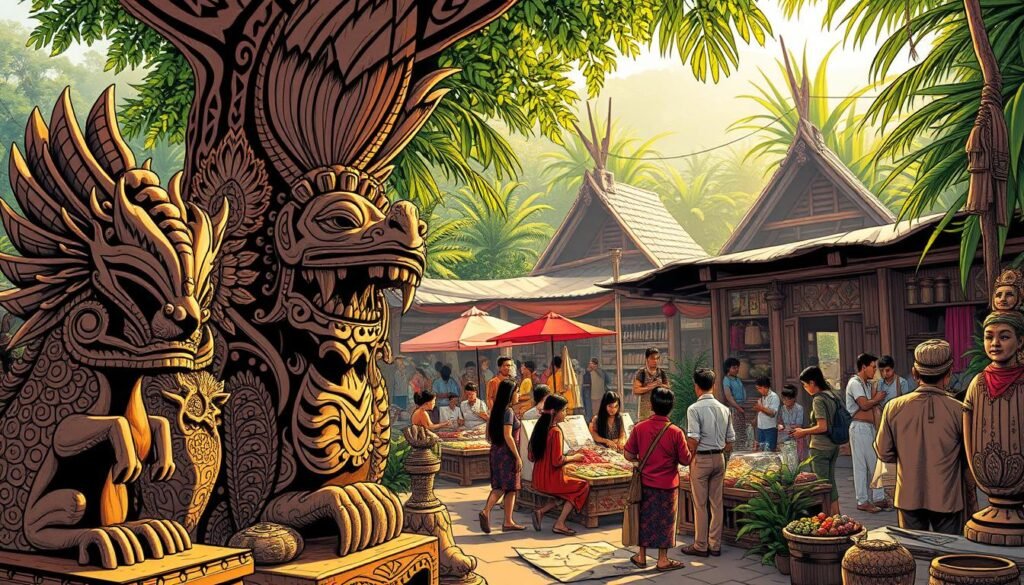
Intercultural exchanges brought innovative carving methods and materials to the Philippines. For example, the introduction of metal tools from China and India revolutionized local sculpture techniques. These tools allowed artisans to create more intricate and durable works, blending traditional styles with foreign influences.
Intercultural Exchange and Its Impact
The Silk Road and other trade routes facilitated the movement of goods and ideas. Pre-colonial Filipinos adopted motifs and designs from neighboring cultures, integrating them into their own artwork. This blending of styles created a unique artistic identity that reflected both local and global influences.
Trade also introduced new materials like gold and ivory, which were used to craft ceremonial objects. These items often symbolized social status and spiritual beliefs. The Agusan image, a gold statuette, is a prime example of how trade influenced the culture and craftsmanship of the time.
By the 13th century, Filipino artisans were producing works that showcased their adaptability and creativity. These pieces not only served practical purposes but also connected communities to the broader world. The legacy of these exchanges continues to inspire modern artists and preserve the rich history of the Philippines.
To learn more about the infrastructure that supported these trade networks, visit this resource.
Iconography and Symbolism in Artifacts
Symbols in ancient Filipino works reveal deep connections to beliefs and traditions. These symbols were not just decorative; they carried profound meanings tied to spirituality and community identity. From carvings to sculptures, every piece tells a story of the culture and history of its creators.
![]()
Spiritual Significance and Rituals
Many pre-colonial artifacts were created for rituals and spiritual practices. For example, the Ifugao rice gods, or bulul, were carved to protect crops and honor ancestral spirits. These objects were believed to hold power, connecting the physical and spiritual world.
Symbols like the cross in Christianity or the dharmachakra in Buddhism served similar purposes. They communicated complex ideas about faith and morality. In pre-colonial Philippines, these symbols were integral to daily life and ceremonies.
Cultural Motifs and Meanings
Recurring themes in pre-colonial art reflect shared values and beliefs. Motifs like the sun, moon, and animals often appeared in carvings and sculptures. These designs symbolized harmony with nature and the cycle of life.
Archaeological findings show how these motifs varied by region. In the Cordilleras, intricate patterns represented agricultural prosperity. In Agusan, gold statuettes like the Agusan image showcased craftsmanship and spiritual devotion.
“Symbols are the language of the soul, bridging the gap between the seen and the unseen.”
These cultural motifs continue to inspire modern artists, preserving the essence of Filipino identity. By studying these symbols, we gain insight into the history and values of early communities.
Nature and Landscape in Pre-Colonial Art
The natural world played a central role in shaping the artistic expressions of pre-colonial Filipinos. From towering mountains to flowing rivers, the environment was more than a backdrop—it was a source of inspiration and symbolism. Early creators captured the essence of their surroundings, embedding it into their artwork.

Landscapes were often depicted as both literal and symbolic representations. For example, the Banaue Rice Terraces, carved into mountainsides, were not just agricultural marvels but also artistic achievements. These terraces reflected the harmony between humans and nature, a recurring theme in pre-colonial culture.
Natural elements like trees, animals, and celestial bodies were common motifs. They symbolized life, growth, and spiritual connection. The Laguna Copperplate Inscription, though primarily a legal document, hints at the importance of nature in early Filipino history.
“The environment was a canvas for the artist, a mirror of their beliefs and values.”
Techniques for capturing nature’s essence varied by region. In the Cordilleras, artisans used intricate patterns to represent agricultural prosperity. In Agusan, goldsmiths crafted detailed statuettes inspired by the natural world. These methods showcased the deep connection between the artist and their environment.
Exploring these works reveals how pre-colonial Filipinos viewed their surroundings. Nature was not just a resource but a partner in their daily life. This perspective continues to influence modern interpretations of the landscape.
To learn more about the role of nature in shaping cultural identity, visit this resource.
Comparative Perspectives: Philippine Art and Global Traditions
The Philippines’ artistic heritage shares fascinating parallels with global traditions, yet it stands out with its unique cultural identity. Pre-colonial Filipino art reflects a blend of indigenous creativity and external influences, offering a rich tapestry of history and culture. By comparing it with other Asian and global traditions, we gain a deeper appreciation of its universal and distinctive elements.
Similarities with Asian Art Forms
Pre-colonial Philippine art shares striking similarities with other Asian traditions. For example, the use of natural materials like wood and stone is common across the region. The Ifugao rice gods, or bulul, resemble the protective deities found in Southeast Asian cultures. Both emphasize harmony with nature and spiritual connection.
Iconography also reveals shared themes. Symbols like the sun and moon appear in Filipino and Indonesian carvings, representing life and renewal. These motifs highlight a universal language of art that transcends borders.
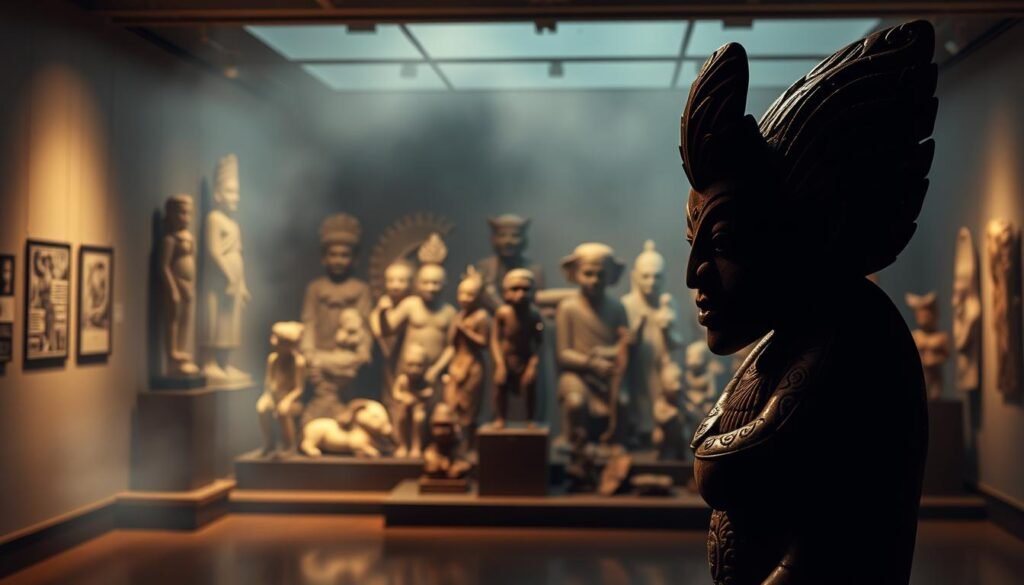
Distinctive Local Elements
While similarities exist, Filipino art also boasts unique features. Indigenous symbols like the bulul and the Agusan image are deeply rooted in local culture. These works reflect the Philippines’ diverse geography and history, setting them apart from other traditions.
Techniques such as direct carving and intricate detailing showcase the artist‘s skill and creativity. These methods, passed down through generations, preserve the essence of Filipino identity.
| Art Form | Philippine Example | Asian Counterpart |
|---|---|---|
| Wood Carving | Ifugao Rice Gods | Balinese Temple Carvings |
| Gold Crafting | Agusan Image | Javanese Gold Jewelry |
| Stone Sculpture | Angono Petroglyphs | Cambodian Stone Reliefs |
This comparative analysis highlights the Philippines’ rich artistic legacy. To explore more about the evolution of Filipino culture, visit this resource.
Evolving Perceptions: Function and Aesthetics
Over centuries, the role of artistic expression has shifted from ritualistic purposes to aesthetic admiration. Early works were often tied to practical or spiritual needs, serving as tools for rituals or symbols of community identity. Today, these same objects are celebrated for their visual and emotional impact, reflecting a profound change in how society views art.
In ancient times, work like the Ifugao rice gods was created to protect crops and honor spiritual beliefs. These pieces were functional, blending seamlessly into daily life. As societies evolved, the focus shifted from utility to beauty, transforming these objects into subjects of admiration and study.
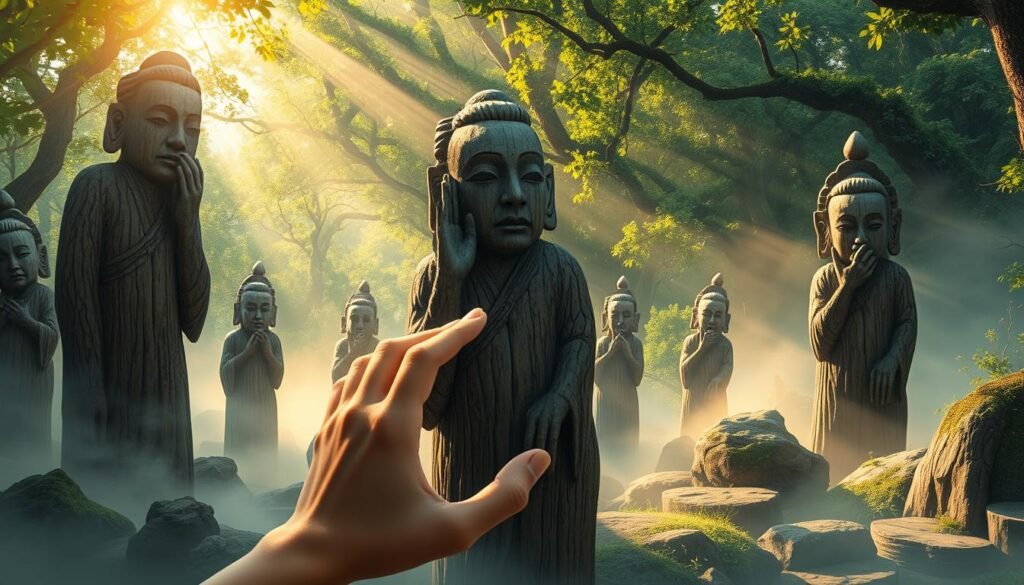
Modern artists often draw inspiration from these early forms, reinterpreting traditional styles in contemporary contexts. This interplay between tradition and innovation highlights the dynamic nature of artistic expression. For example, the intricate patterns of pre-colonial carvings can be seen in today’s abstract forms, bridging the gap between past and present.
The evolution of art history reveals how societal values shape artistic creation. From the Angono Petroglyphs to modern installations, each period reflects the culture and priorities of its time. This ongoing dialogue between function and aesthetics continues to redefine the subject of art.
To explore more about the psychology of art and aesthetics, visit this resource.
| Period | Function | Aesthetic Focus |
|---|---|---|
| Pre-Colonial | Ritualistic, Practical | Symbolism, Community Identity |
| Modern | Decorative, Emotional | Visual Appeal, Innovation |
This transformation underscores the enduring relevance of artistic expression in shaping the world around us. By understanding this evolution, we gain deeper insight into the history and culture that define our shared heritage.
Legacy in Modern Philippine Culture
The vibrant traditions of pre-colonial Philippines continue to inspire modern artistic expressions, bridging the past and present. From intricate carvings to symbolic designs, these ancient practices have found new life in contemporary culture. This revival not only preserves heritage but also shapes the nation’s identity.
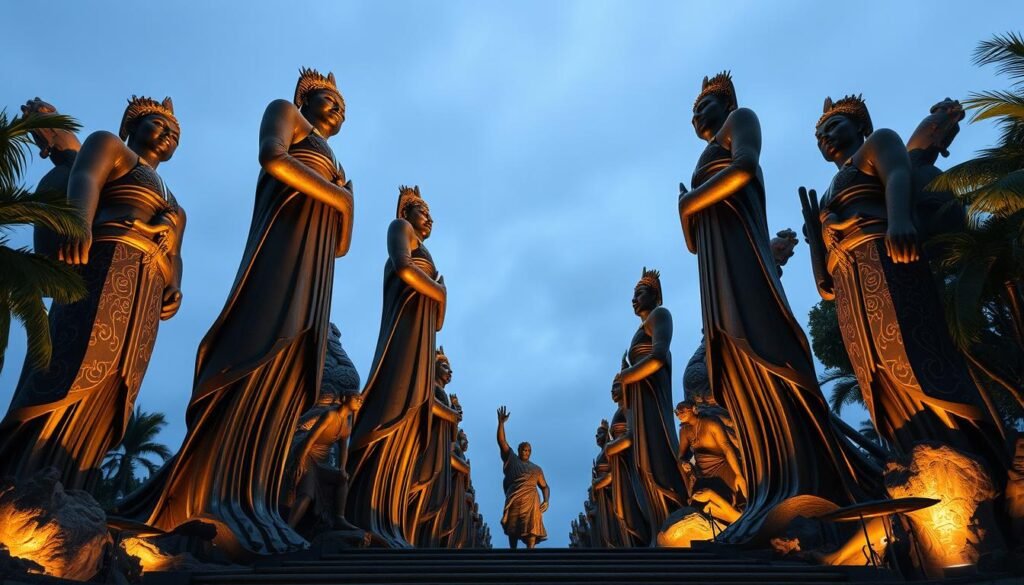
Contemporary Revival of Traditional Forms
Modern artists are reinterpreting pre-colonial techniques, blending them with innovative styles. For example, the Ifugao rice gods, once carved for agricultural rituals, now appear in abstract sculptures. This fusion of old and new highlights the adaptability of Filipino art.
Exhibitions across the Philippines showcase these reinterpretations. The National Museum, for instance, features works that celebrate pre-colonial heritage. These displays remind viewers of the rich history that continues to influence the world of art.
Influence on Modern Sculptors
Contemporary sculptors draw inspiration from ancient methods and motifs. Artists like Abdulmari Imao incorporate traditional patterns into their work, creating pieces that resonate with modern audiences. This approach keeps the essence of pre-colonial culture alive.
Workshops and festivals also play a role in this revival. Events like the Pahiyas Festival encourage artisans to explore traditional styles. These gatherings foster creativity while honoring the past.
| Artist | Influence | Notable Work |
|---|---|---|
| Abdulmari Imao | Traditional Patterns | “Sarimanok” Series |
| Leeroy New | Environmental Themes | “Balete” Installations |
| Kublai Millan | Cultural Symbols | “Datu Bago” Sculpture |
The legacy of pre-colonial art is more than a historical fact; it’s a living form of expression. By embracing these traditions, modern creators ensure that the Philippines’ cultural heritage remains vibrant and relevant.
Preservation: Challenges and Opportunities
Preserving pre-colonial artifacts is a race against time, as natural and human factors threaten their survival. These objects, which hold immense cultural and historical value, face risks from environmental changes, urbanization, and even conflict. Protecting them requires a combination of modern techniques and traditional knowledge.
Conservation Efforts and Cultural Sustainability
Museums and cultural institutions play a crucial role in safeguarding these treasures. For example, the National Museum of the Philippines has implemented advanced conservation methods to protect delicate wooden carvings and gold artifacts. These efforts ensure that future generations can appreciate the art and culture of their ancestors.
Community involvement is equally important. Local custodians often possess traditional knowledge that complements modern conservation practices. By engaging these communities, institutions can create sustainable preservation strategies that respect cultural heritage.
Government policies also play a vital role. Legislation that protects historical sites and funds conservation projects is essential. Non-profit organizations often bridge the gap between government initiatives and local efforts, ensuring that preservation is a collaborative endeavor.
“Preserving cultural heritage is not just about protecting objects; it’s about safeguarding identity and memory.”
Despite these efforts, challenges remain. Natural disasters, such as earthquakes and floods, can cause irreparable damage. Urbanization often leads to the destruction of historic sites. Addressing these threats requires innovative solutions and international collaboration.
For those interested in the challenges of conserving contemporary art, the lessons learned from pre-colonial preservation can offer valuable insights. Both fields require a balance of tradition and innovation to protect cultural heritage.
Integrating Art History with National Identity
The history of art in the Philippines is a mirror reflecting the nation’s evolving identity. From pre-colonial carvings to modern interpretations, these works tell a story of cultural resilience and creativity. They serve as a bridge between the past and present, shaping how Filipinos view themselves and their culture.
Pre-colonial art forms, such as the Ifugao rice gods and the Agusan image, were more than just objects. They were symbols of community values and spiritual beliefs. Today, these pieces inspire modern artists to explore their heritage, creating works that resonate with contemporary audiences.
“Art is not just a reflection of society; it is a tool for shaping identity.”
Educational initiatives play a crucial role in preserving this legacy. Schools and museums across the Philippines teach the next generation about their artistic heritage. Public outreach programs, like exhibitions and workshops, bring these historical works to life, fostering a deeper connection to the nation’s history.
Impact on Cultural Consciousness
Historical artworks contribute to a shared sense of belonging and pride. They remind Filipinos of their rich culture and the values that define their identity. For example, the Angono Petroglyphs, dating back to 3000 BC, are a testament to the creativity and resilience of early communities.
Modern interpretations of these works continue to shape cultural consciousness. Artists like Abdulmari Imao and Leeroy New draw inspiration from traditional forms, blending them with contemporary styles. This fusion keeps the essence of Filipino art alive, ensuring it remains relevant in a rapidly changing world.
To learn more about how visual culture shapes national identity, visit this resource.
Conclusion
The rich tapestry of pre-colonial Filipino craftsmanship continues to inspire modern interpretations, blending tradition with innovation. These ancient art forms, from intricate carvings to symbolic sculptures, reflect a deep connection to cultural identity and spiritual beliefs. Their enduring legacy highlights the technical mastery and creativity of early artisans.
Preserving these works is essential to understanding the Philippines’ rich culture. Museums and cultural initiatives play a vital role in safeguarding this heritage, ensuring future generations can appreciate its significance. By exploring these collections, we gain a new appreciation for the artistry and values of the past.
As we celebrate these traditions, it’s a fact that their influence extends beyond history. They shape modern art and inspire contemporary creators to reinterpret ancient forms. To learn more about the creative process behind such works, visit this resource.
Let us continue to honor and preserve these treasures, ensuring the essence of Filipino heritage remains alive for generations to come.
FAQ
What materials were commonly used in pre-colonial Philippine sculptures and carvings?
Early artisans often used wood, stone, and ivory as primary materials. These were chosen for their durability and availability in the region.
How did trade influence pre-colonial Philippine art?
Trade introduced new materials, techniques, and cultural motifs. This exchange enriched local styles and expanded artistic expression.
What role did spirituality play in pre-colonial art?
Many artifacts held spiritual significance, often used in rituals or as representations of deities and ancestral spirits.
How did nature inspire pre-colonial Philippine art?
Nature was a central theme, with landscapes, animals, and plants frequently depicted to reflect the environment and its importance in daily life.
What are the defining characteristics of pre-colonial Philippine sculptures?
These works often featured intricate details, symbolic motifs, and a strong connection to cultural and spiritual beliefs.
How has pre-colonial art influenced modern Philippine culture?
Contemporary artists and sculptors draw inspiration from traditional forms, reviving ancient techniques and motifs in modern works.
What challenges exist in preserving pre-colonial art?
Conservation faces issues like environmental damage, lack of resources, and the need for greater public awareness and support.
How does pre-colonial art contribute to national identity?
It serves as a vital link to the Philippines’ cultural heritage, fostering pride and a deeper understanding of its history and traditions.
What tools were traditionally used in carving?
Artisans relied on simple tools like chisels, adzes, and knives, crafted from stone, bone, or metal, to create detailed works.
How does pre-colonial Philippine art compare to other Asian art forms?
While sharing similarities in themes and techniques, it also features unique local elements that distinguish it from neighboring traditions.
Source Links
- Arts in the Philippines
- Southeast Asian arts – Philippine Music, Dance, Crafts | Britannica
- Exploring Pre Colonial Art In The Philippines
- The Evolution of Filipino Art: A Journey Through Time
- Exploring Pre Colonial Art In The Philippines
- Petroglyphs of Angono: Unraveling the Mysteries of Ancient Philippine Art – Pinas Culture
- Cultural achievements of pre-colonial Philippines
- Answers to: Write an essay about what i learned about Pre-Colonial Visual Arts In the Philippines
- Historical Perspectives on Philippine Contemporary Art – New Mandala
- Latin American art | History, Artists, Works, & Facts | Britannica
- Sculpture – Carving, Materials, Techniques | Britannica
- Explore the Basics of Sculpture
- Sculpture techniques · V&A
- Trade Routes between Europe and Asia during Antiquity – The Metropolitan Museum of Art
- Cultural globalization | Pros, Cons, Examples, Impact, & Factors | Britannica
- Symbolism – The Metropolitan Museum of Art
- Religious symbolism and iconography | Description, Meaning, Types, Influence, & Facts | Britannica
- 1.4: Symbolism and Iconography
- The Pre-Colonial Philippines: a Glimpse Into Ancient Societies – Pinas Culture
- Philippines – Culture, Diversity, Traditions | Britannica
- Bayanihan Philippine Art Project
- Frontiers | Art and Perception: Using Empirical Aesthetics in Research on Consciousness
- Aesthetic Experience
- Aesthetic Theory: Understanding Beauty, Art, and Human Perception
- Flourishing Culture: The Arts in the Philippines –
- Culture of the Philippines
- Purkh
- Practices and challenges of cultural heritage conservation in historical and religious heritage sites: evidence from North Shoa Zone, Amhara Region, Ethiopia – npj Heritage Science
- Preserving Cultural Heritage in War-Torn Iraq: Challenges and Imperatives
- Microsoft Word – ACERP2018_39527.doc
- Identity Art & Identity Politics Movement Overview
- Conclusion – National Museum of Asian Art
- Conclusion – Pop Art and the Origins of Post-Modernism

